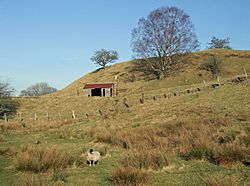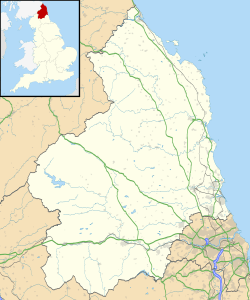Tarset Castle facts for kids
Quick facts for kids Tarset Castle |
|
|---|---|
| Northumberland, England, UK | |

The ruins of Tarset Castle (in the background)
|
|
|
Location in Northumberland
|
|
| Coordinates | 55°09′47″N 2°20′02″W / 55.163°N 2.334°W |
Tarset Castle is an old ruined castle located near the village of Tarset in Northumberland, England. This historic site holds many secrets from a time long ago. Today, only some stone foundations remain of what was once a strong fortress.
The Castle's Story
Tarset Castle has a fascinating history, even though not much of it stands today. It was built in the 13th century, a time when castles were very important for protection.
Building Tarset Castle
In 1267, a man named John Comyn received special permission to build the castle. This permission was called a "licence to crenellate." It meant he was allowed to add battlements and other defenses to his building. These features made it look like a proper castle. The castle was built about half a mile southwest of the modern village of Tarset. It was designed with four square towers at each corner. These towers helped protect the castle from attackers.
When the Castle Was Destroyed
Tarset Castle did not stand for very long. It was destroyed by Scottish forces in June 1314. This happened shortly after a very important battle called the Battle of Bannockburn. In this battle, Scottish forces won a major victory against the English. After their win, the Scots moved into Northumberland. They destroyed many castles and strongholds, including Tarset Castle.
What Remains Today
Today, you can still see some parts of Tarset Castle. All that is left are stone foundations on top of a small hill. These foundations show where the castle walls once stood. In 1861, a railway line was built through the area. This railway, called the Border Counties Railway, cut right through the old castle site.
The remains of Tarset Castle are considered a very important historical site. They are listed as a "Grade II* listed" structure. This means the site is protected because of its special historical interest. It helps us remember the past and the conflicts that shaped the region.


